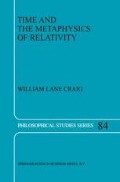Abstract
There are obviously many other ramifications of Special Relativity, but as our interest is in the time concept in relativity, the brief survey in the foregoing chapters will suit our purposes. SR is one of the pillars of modern physics. Bondi has said that “...there is perhaps no other part of physics that has been checked and tested and cross-checked quite as much as the Theory of Relativity.”1 According to J. G. Taylor, “as far as special relativity is concerned all has been worked out and tested;” the theory has enjoyed “remarkable successes, and absolutely no failures.”2 Let us review the principal empirical confirmations of the theory.
Access this chapter
Tax calculation will be finalised at checkout
Purchases are for personal use only
Preview
Unable to display preview. Download preview PDF.
References
Hermann Bondi, Relativity and Common Sense (New York: Dover Publications, 1964), p. 168.
J. G. Taylor, Special Relativity,Oxford Physics Series (Oxford: Clarendon Press, 1975), preface.
L. H. Thomas, “The Kinematics of an Electron with an Axis,” Philosophical Magazine (1927): 1.
Roy J. Kennedy and Edward M. Thomdike, “Experimental Establishment of the Relativity of Time,” Physical Review 42 (1932): 400.
H. E. Ives, “Historical Note on the Rate of a Moving Clock,” Journal of the Optical Society of America 37 (1947): 810; cf. L. Janossy, Theory of Relativity Based on Physical Reality ( Budapest: Akadémiai Kiadó, 1971 ), p. 62.
E. J. Williams, “The Loss of Energy by B-Particles and its Distribution between Different Kinds of Collisions,” Proceedings of the Royal Society A 130 (1931): 328–346.
Hubert E. Ives and G. R. Stilwell, “An Experimental Study of the Rate of a Moving Atomic Clock,” Journal of the Optical Society of America 28 (1938): 215–226; idem, “An Experimental Study of the Rate of a Moving Atomic Clock. II,” Journal of the Optical Society of America 31 (1941): 369–374.
Arthur I. Miller, Albert Einstein’s Special Theory of Relativity (Reading, Mass.: Addison-Wesley, 1981), p. 266. This is because “The various experiments utilizing elementary particles involve a vicious circle because their data analysis depends on special relativity; consequently these experiments test only the consistency of the special theory of relativity.” In this judgement, he concurs with Herbert Dingle, “Time in Relativity Theory: Measurement or Coordinate?,” in The Voices of Time, 2d ed., ed. with a new Introduction by J. T. Fraser (Amherst, Mass.: University of Massachusetts Press, 1981), pp. 469–470; idem, Science at the Crossroads (London: Martin Brian and O’Keefe, 1972), pp. 34, 143, 149, 208.
Ives and Stilwell, “Experimental Study. II,” p. 374.
Bruno Rossi and J. Barton Hoag, “The Variation of the Hard Component of Cosmic Rays with Height and the Disintegration of Mesotrons,” Physical Review 57 (1940): 461–469; Bruno Rossi and David B. Hall, “Variation of the Rate of Decay of Mesotrons with Momentum,” Physical Review 59 (1941): 223–228; David H. Frisch and James H. Smith, “Measurement of the Relativistic Time Dilation Using μ-Mesons,” American Journal of Physics 31 (1963): 342.
R. Durbin, H. H. Loar, and W. W. Havens, “The Lifetime of the n + and n–Mesons,” Physical Review 88 (1952): 179–183.
Chalmers W. Sherwin, “Some Recent Experimental Tests of the ‘Clock Paradox’,” Physical Review 120 (1960): 17–21.
H. J. Hay, J. P. Schiffer, T. E. Cranshaw, and P. A. Egelstaff, “Measurement of the Red Shift in an Accelerated System Using the Mössbauer Effect in Fe,” Physical Review Letters 4 (1960): 165.
J. C. Hafele and R. E. Keating, “Around the World Atomic Clocks: Predicted Relativistic Time Gains,” Science 177 (14 July 1972): 166–168; idem, “Around the World Atomic Clocks: Observed Relativistic Time Gains,” Science 177 (14 July 1972): 168–170. They conclude: “These results provide an unambiguous empirical resolution of the famous clock ‘paradox’ with macroscopic clocks” (Ibid., p. 168). Unfortunately the dilation is too small to be detected with non-atomic timepieces.
Author information
Authors and Affiliations
Editor information
Editors and Affiliations
Rights and permissions
Copyright information
© 2001 Springer Science+Business Media Dordrecht
About this chapter
Cite this chapter
Craig, W.L. (2001). Empirical Confirmation of SR. In: Craig, W.L. (eds) Time and the Metaphysics of Relativity. Philosophical Studies Series, vol 84. Springer, Dordrecht. https://doi.org/10.1007/978-94-017-3532-2_4
Download citation
DOI: https://doi.org/10.1007/978-94-017-3532-2_4
Publisher Name: Springer, Dordrecht
Print ISBN: 978-90-481-5602-3
Online ISBN: 978-94-017-3532-2
eBook Packages: Springer Book Archive

